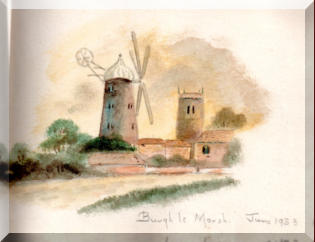
























































The 5 sailed windmill that should turn clockwise

Welcome


Following meetings with Lincolnshire
County Council personnel and elected
representatives, and inevitable delays
in building we are now pleased to be
able to offer a full tour and other
display features.
Fortunately we have a few stalwart
volunteers remaining whose number
has been augmented by willing ‘fresh
faces’ and the site is open to visitors
on
Sundays 2pm to 4pm

A unique experience as
you step back in time. The
mill is very much a
heritage piece as you
might expect of a Grade 1
listed building.
While some historians
think the mill was built
around 1813, a map from
1810 shows a windmill
already on the site.
The current mill tower
was most likely built in
1844.
What is certain is that
the mill was worked as a
commercial concern by
the last owners, Dobsons,
until the 1960s. It was
then purchased for
preservation by the
County Council and has
been run since by groups
of volunteers.
The BLM Heritage Group
is now custodian of the
site.

Due to the failings of LCC personnel
(and sub-contractors)
and given the financial constraints
placed upon them,
on 9th February 2020 our beautiful
mill was reduced to a rump and we
are awaiting the second part of the
schedule for repair.
It has not stood like this
for so long a time
during its 178 years



The 5 sailed windmill that should turn clockwise

Welcome



Following meetings with Lincolnshire County
Council personnel and elected
representatives, and inevitable delays in
building we are now pleased to be able to
offer a full tour and other display features.
Fortunately we have a few stalwart
volunteers remaining whose number has
been augmented by willing ‘fresh faces’ and
the site is open to visitors on
Sundays 2pm to 4pm

A unique experience as you step back in
time. The mill is very much a heritage piece
as you might expect of a Grade 1 listed
building.
While some historians think the mill was
built around 1813, a map from 1810 shows a
windmill already on the site.
The current mill tower was most likely built
in 1844.
What is certain is that the mill was worked
as a commercial concern by the last owners,
Dobsons, until the 1960s. It was then
purchased for preservation by the County
Council and has been run since by groups of
volunteers.
The BLM Heritage Group is now custodian of
the site.


Due to the failings of LCC personnel
(and sub-contractors)
and given the financial constraints
placed upon them,
on 9th February 2020 our beautiful
mill was reduced to a rump and we
are awaiting the second part of the
schedule for repair.
It has not stood like this
for so long a time
during its 178 years















